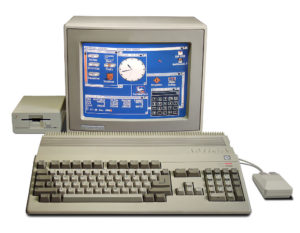Amiga 500
The bestselling Amiga of all time… This was the machine that turned things around for Commodore when it was released in 1987. It had a revised version of the design used in the Amiga 1000, which was cheaper to manufacture, and was aimed at the home market. It was the first Amiga model to be available in the familiar “keyboard wedge” shape, where the keyboard housed the computers mainboard and disk drive. It also came with what was the latest versions of Kickstart 1.2 and Workbench 1.2 at the time, and was the first Amiga to be sold with video games, as well as productivity software, in the box.
The changes it had were also added into the first major revision of the Amiga 2000, to which it was very closely related.
Over time, there were many running changes to the Amiga 500 mainboard, here are the most common versions and what the differences were to the main board – there were many other differences such as what floppy drive was used, but we’ll keep it to the differences to the main PCB and chips here:
Revision 3:
– 28 MHz clock may be provided either by discrete circuit (early ones) or a (likely more reliable) standalone oscillator can (later ones), the PCB can accommodate either option
– Low-pass audio filter cannot be turned off
– Came with a Toshiba-made buggy Gary
– 8370/71 (NTSC/PAL) “fat” Agnus
– Uses 16 256K x1 chips for 512 KB onboard chip RAM
– PCB has no provisions for easy Agnus/chip RAM upgrade (JP2 on this board has a completely different use from subsequent revs), by default only the 512 KB chip RAM + 512 KB slow RAM (on trapdoor) is supported
Revision 5:
– Low-pass audio filter can be turned off
– Early ones still had the Toshiba Gary (but included a transistor fix), later ones used the corrected Commodore version
– 8370/71 (NTSC/PAL) “fat” Agnus
– Uses 16 256K x1 chips for 512 KB onboard chip RAM
– PCB has partial provisions for easy Agnus/chip RAM upgrade (JP2 can map trapdoor RAM to $80000 in “chip RAM space”, but other steps must also be taken)
Revisions 6A/7:
– Rev7 is ultra scarce and identical to rev6A. Why it was the 6A (which sounds experimental) that was widely deployed remains a mystery.
What is no mystery is that rev6A represents the vast majority of Amigas sold and is the ‘de facto’ A500 motherboard.
– Dims the power LED instead of turning it completely off (as with revs 3/5)
– Uses 4 256K x4 RAM chips for 512 KB onboard chip RAM (bank0), with another 4 empty spots (bank1) available. Chips installed there are normally mutually exclusive with a trapdoor RAM expansion.
– Uses the 8273A ECS Agnus (dual PAL/NTSC capable), but early runs still have the 8370/71, requiring an “upside down” RAM-refresh fix near the trapdoor connector to support the new x4 RAM chips.
– PCB has full provisions to enable 1 MB of chip RAM (JP2, JP7A), full RAM bank0/1 swap (JP3 block), PAL/NTSC switching (JP4 block) and can even fully support the 8372B 2 MB Agnus in single-RAS mode (JP5 block, although the 4 existing 256Kx4 RAM chips must be removed and 4 new 1Mx4 chips must be installed in the previously empty spots).
Revision 8A(.1)
– Similar to 6A/7, but with provision for onboard RTC (A500+ config) and a 42-pin instead of 40-pin ROM socket (2 extra pins not used)
– Uses exclusively the 2 MB 8375 Agnus (390544-01/02 or 318069-10/11 , PAL/NTSC resp.)
– PCB 8A.1 simply corrects a minor trace fault in the RTC area. Typically factory-fixed on rev8A boards too, which come with an 8A.1 sticker.
– Can be configured either to A500 or to A500+ specs. Silkscreened on PCB is A500+
– Under A500+ specs the ECS Denise, KS 2.04, a battery-backed RTC and 1 MB chip RAM are onboard, with the option of up to another 1 MB chip RAM on the trapdoor (slow RAM is not supported)
– Under A500 specs the OCS Denise, KS 1.3, no RTC and 0.5 MB chip RAM are onboard, with the option of up to another 512 KB on the trapdoor (configured as either chip or slow RAM via JP2/JP7A as in rev6A boards), but occasionally an ECS Denise and/or a 2.04 ROM have been spotted.
| CPU: | Motorola 68000 @ 7.16MHz (NTSC) Motorola 68000 @ 7.09MHz (PAL) |
| Chip RAM: | Standard 512K |
| Maximum resolution: | 640×400 (NTSC) 640×512 (PAL) (16 colour maximum in 640x resolutions) * |
| Kickstart versions: | 1.2 1.3 |
| Workbench version: | 1.2 1.3 |
| Total RAM: | 512K (expandable to 1MB with the A501 RAM expansion module) |
| Price in 1987: (US Dollars) |
$699 |
Advertising Material:
Amiga 500 Brochure
Documentation:
Introduction to the Commodore Amiga 500
A520 Video Adapter User’s Manual
Amiga BASIC
Commodore AmigaDOS V1.3 Enhancer Software
The Complete Amiga 500 User Guide
Amiga 500 Service Training
A500 Batman pack UK (Deluxe Paint II, Workbench 1.3 and Extras 1.3, F/A-18 Interceptor, The New Zealand Story, Batman, A520 TV modulator, Amiga 500, Amiga Mouse)
Amiga 500 accelerators (make the machine faster) on the Big Book of Amiga Hardware
| <- Back to Amiga 2000 | On to Amiga 3000 -> |
